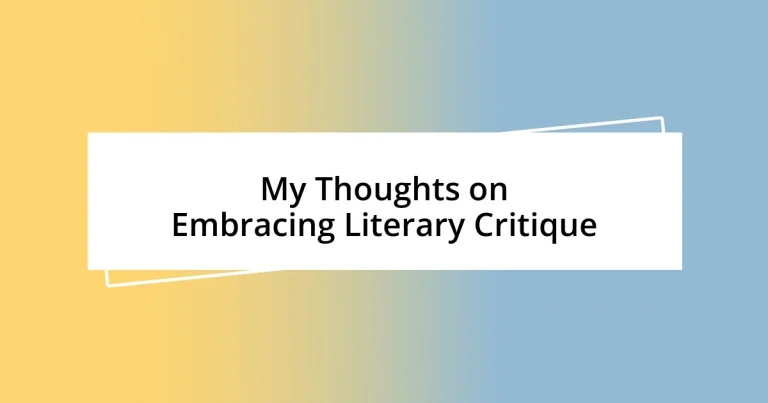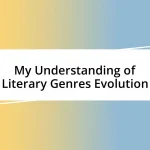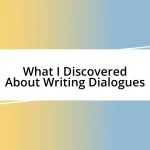Key takeaways:
- Engaging in literary critique transforms reading from passive observation to an active dialogue, unveiling deeper emotional and thematic layers of texts.
- Embracing diverse literary theories enriches interpretations, allowing readers to explore texts from multiple perspectives and fostering a more empathetic understanding.
- Applying constructive feedback, both as a writer and reader, leads to personal growth, resilience, and improved analytical skills, enhancing overall engagement with literature.

Understanding Literary Critique
Understanding literary critique is like unlocking a new layer of appreciation for a text. I remember the first time I sat down with a classic novel, and a friend guided me through its themes and symbols. It felt as if I were seeing the story for the first time, as if every page was bursting with unspoken secrets waiting to be uncovered.
When we engage with literary critique, we’re not just dissecting words; we’re diving deep into the emotions and intentions behind them. Have you ever found yourself pondering why a character made a particular choice? That curiosity is the essence of critique, transforming our reading experience from passive observation to an active conversation with the text and its creator.
It’s also essential to recognize that literary critique holds a mirror to our own lives and beliefs. I often reflect on how my interpretations evolve as I grow older. Each reading becomes a new conversation, revealing fresh insights about the world and, more importantly, about myself. Isn’t it fascinating how literature can resonate differently depending on our circumstances?

Importance of Embracing Critique
Embracing critique can significantly elevate our understanding and appreciation of literature. I recall a workshop where I shared a piece I was particularly proud of. The feedback was eye-opening, revealing aspects I hadn’t even considered. It reminded me that critique isn’t about tearing down work; rather, it’s about building a deeper connection to the text and enhancing its impact. Engaging with feedback transforms us into more thoughtful readers and writers, enabling our growth in both fields.
When we accept critique, we open doors to new perspectives that challenge our preconceived notions. This is pivotal because:
- Self-Discovery: Critique often highlights our blind spots, encouraging introspection.
- Improved Craft: Constructive feedback can sharpen our writing skills, refining our voice and style.
- Stronger Connections: Understanding differing viewpoints fosters empathy, deepening our relationship with characters and stories.
- Enhanced Analytical Skills: Critique teaches us to dissect texts thoughtfully, preparing us for deeper literary discussions.
- Confidence Building: Receiving and applying feedback can bolster our confidence as creators and critics alike.

Navigating Different Literary Theories
Navigating the landscape of literary theories can be a thrilling yet daunting experience. As I delved into different theories, I remember feeling like an explorer charting unfamiliar territory. Each theory—whether it be Marxist, Feminist, or Psychoanalytic—offered a unique lens through which I could view a text, uncovering motivations and social commentaries I had never noticed before. This variety ensures that no two readings are ever truly the same, which adds depth to our experiences as readers.
While I often gravitate towards a specific theory, I’ve learned to appreciate the interplay between them. For example, using a Feminist lens on a classic novel illuminated the power dynamics between characters in a way that a Historical Lens might not. This realization reminded me of a discussion I once had in a literature class, where we debated character motivations based on different theoretical frameworks. That exchange marked a turning point in my understanding, showing me that embracing multiple perspectives enriches our interpretations significantly.
Embracing different literary theories isn’t just about acquiring knowledge; it’s about transforming our reading habits. When I approach a text with a new theoretical perspective, I can’t help but feel excitement bubble inside me. It’s as if I’m unearthing hidden treasures with every page turn. The beauty of this endeavor is that it turns every reading into a multi-dimensional journey. By recognizing the multitude of interpretations, we cultivate a richer, more empathetic understanding of literature and the voices within it.
| Literary Theory | Main Focus |
|---|---|
| Marxist | Class struggle and socio-economic factors |
| Feminist | Gender inequalities and female perspectives |
| Psychoanalytic | Character motivations and unconscious desires |
| Structuralist | Underlying structures and conventions in texts |

Developing Critical Reading Skills
When I first started to hone my critical reading skills, I remember feeling overwhelmed by the plethora of ideas and interpretations bouncing around in discussions. It felt like trying to catch butterflies in a field—so much beauty, yet so elusive. But what I discovered over time was that asking questions about the text really helped me engage more deeply. For instance, when I encountered a challenging narrative, I found it valuable to pause and ask myself, “What are the underlying themes here?” That mindset shift changed the way I read altogether.
As I immersed myself in various texts, I began to recognize patterns and techniques that authors used to convey their messages. It struck me that dissecting a passage wasn’t just an academic exercise; it felt more like peeling back the layers of an onion, revealing the core ideas and emotions within. I recall analyzing a seemingly simple poem and discovering its rich symbolism after multiple readings. It was exhilarating to realize how much depth could lie beneath the surface of a few carefully chosen words.
A key component of developing critical reading skills is learning to separate personal biases from the text itself. I’ve often found myself reacting emotionally to storylines or characters, which can cloud my judgment. To counter this, I started keeping a reading journal, noting down my initial reactions versus my analytical thoughts. This practice not only helped me reflect on my personal biases but also enhanced my ability to appreciate the text itself. Have you ever considered how your emotions shape your interpretations? It’s a worthwhile question that I encourage you to ponder as you explore literature more critically.

Applying Feedback for Growth
Receiving feedback, whether from peers or mentors, can be a source of true growth. I vividly remember a workshop where I presented a piece I felt proud of, only to be met with critiques that stung at first. But, as I revisited those comments, I realized they were stepping stones toward improvement. It’s essential to sit with that discomfort and sift through the feedback for the golden nuggets of insight that can lead us to a stronger version of our original work.
In my experience, implementing feedback isn’t just about making changes; it’s a transformative journey. After incorporating critiques into my writing, I often find myself in a dialogue with my earlier drafts. Each revision feels like a conversation—one where my past self challenges my current perspective, urging me to clarify my thoughts and deepen my narratives. Have you ever noticed how a single piece of constructive criticism can spark a whole new line of thinking? I’ve seen it happen time and again, reshaping my initial ideas into something more cohesive and powerful.
Moreover, the act of applying feedback teaches me resilience. I’ve had pieces that felt like monumental failures when saturated with comments, yet working through that process reminded me of why I love creating in the first place. It’s that balance between vulnerability and courage that transforms feedback into fuel. How do you respond to criticism? Instead of fearing it, I’ve learned to welcome it as a guide pointing the way to my growth, both as a writer and a thinker.

Engaging in Constructive Discussions
Engaging in discussions about literature can be invigorating, but I’ve found that they truly thrive on constructive dialogue. Take my experience at a local book club, for instance. Initially, I felt hesitant to share my thoughts, worried about what others might think. However, when I finally voiced my interpretation of a character’s motives, the ensuing conversation opened my eyes to perspectives I’d never considered. It was a reminder that each person brings their own unique lens to the table, enriching the discussion in unexpected ways.
I’ve noticed that asking open-ended questions during discussions fosters a deeper understanding of the material. For instance, when someone posed the question, “What do we think the author is trying to say about society?” it transformed our conversation from surface-level comments into a meaningful exploration of themes. This shift not only enhances our critical thinking but also encourages others to reflect on their viewpoints. Have you ever found that a single question can pivot the entire tone of a discussion? It truly can, prompting more introspection and engagement among participants.
Furthermore, embracing constructive discussions means being open to diverse opinions, even those that challenge our own. I recall a heated debate about a novel’s ending where my viewpoint was significantly different from someone else’s. Instead of feeling defensive, I allowed myself to listen and consider their arguments, which sparked a revelation in my thinking. This exchange taught me that understanding opposing perspectives doesn’t undermine my beliefs; it strengthens my appreciation for literature’s complexity. How often do we find ourselves missing out on rich insights simply because we close ourselves off from differing opinions? Engaging fully in these discussions can lead to transformative understanding, both of the text and ourselves.

Cultivating a Critical Mindset
Cultivating a critical mindset is like training a muscle; it requires consistent practice and patience. I remember diving into a piece of literature that I initially found boring. Instead of closing the book, I challenged myself to dissect each chapter, questioning why the author made certain choices. This exercise turned my frustration into curiosity, revealing layers of meaning I’d previously overlooked. Have you ever transformed your perspective on something just by digging deeper?
Engaging with a text critically means embracing ambiguity and complexity. I vividly recall attending a lecture where the professor presented a reading that conflicted with my interpretation. Rather than retreating into defensiveness, I leaned into that discomfort. I started to see how my biases influenced my understanding and how valuable it was to confront them. What if our differences in interpretation could enrich our collective understanding? This realization fostered a deeper appreciation for literary critique as a tool for self-discovery.
Moreover, I’ve come to realize that being critical doesn’t equate to being negative. My approach has shifted from assessing what’s wrong to exploring how something can be better. For instance, a story I once critiqued felt flawed to me, yet as I re-read it, I began framing my critique as an opportunity for dialogue—what could I learn from the author’s choices? This shift in mindset not only benefits my writing but also deepens my connection to the text itself. How often do we forget that every critique we offer can be a pathway to greater understanding? Embracing this perspective transforms us into more thoughtful and engaged readers.














